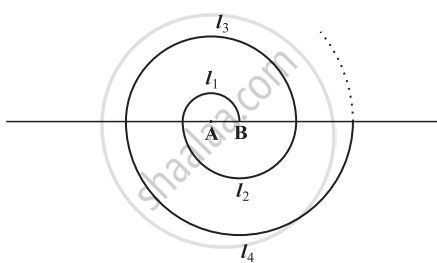Advertisements
Advertisements
Question
Find the common difference of an A.P. whose first term is 5 and the sum of first four terms is half the sum of next four terms.
Solution
Let a and d be the first term and common difference of A.P. respectively.
Given, a = 5
a1 + a2 + a3 + a4 = `(1)/(2)` (a5 + a6 + a7 + a8)
∴ a + (a + d) + (a + 2d) + (a + 3d)
= `(1)/(2)[(a + 4d) + (a + 5d) + (a + 6d) + (a + 7d)]`
⇒ 2(4a + 6d) = (4a + 22d)
⇒ 2(20 + 6d) = (20 + 22d) ...(∵ a = 5)
⇒ 40 + 12d = 20 + 22d
⇒ 10d = 20
⇒ d = 2
Thus, the common difference of A.P. is 2.
APPEARS IN
RELATED QUESTIONS
A spiral is made up of successive semicircles, with centres alternately at A and B, starting with centre at A of radii 0.5, 1.0 cm, 1.5 cm, 2.0 cm, .... as shown in figure. What is the total length of such a spiral made up of thirteen consecutive semicircles? (Take `pi = 22/7`)

[Hint: Length of successive semicircles is l1, l2, l3, l4, ... with centres at A, B, A, B, ... respectively.]
Find the sum of all 3-digit natural numbers, which are multiples of 11.
Which term of the AP 21, 18, 15, …… is -81?
The sum of the first n terms of an AP is (3n2+6n) . Find the nth term and the 15th term of this AP.
What is the sum of first 10 terms of the A. P. 15,10,5,........?
If the sum of first p term of an A.P. is ap2 + bp, find its common difference.
The 9th term of an A.P. is 449 and 449th term is 9. The term which is equal to zero is
Find the sum of those integers from 1 to 500 which are multiples of 2 as well as of 5.
The ratio of the 11th term to the 18th term of an AP is 2 : 3. Find the ratio of the 5th term to the 21st term, and also the ratio of the sum of the first five terms to the sum of the first 21 terms.
Find the sum of all even numbers from 1 to 250.
